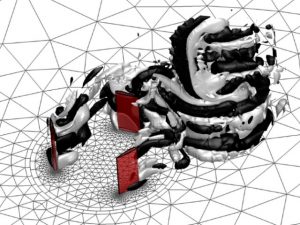We aim to develop more efficient numerical algorithms by making use of new acceleration hardware platforms to increase the Numerical Simulation tools capabilities. It has been shown that these tools are currently suffering two main drawbacks that prevent their full industrial deployment for massive applications: excessively long computational times for problems of industrial relevance, and reliability and accuracy of their solutions.
Our researchers have a long list of projects in cooperation with industrial partners (see key researchers). Also, have a very active collaboration with Airbus in numerical methods for fluid dynamics simulation for aeronautics, as well as other collaborations with HP.
Furthermore, we also have a strong experience in the application of numerical methods and simulation in many of the different topics mentioned above, and our researcher are becoming a reference group for the industry in this kind of problems. In particular:
- Development of CFD solvers faster and robust in steady and non-steady conditions.
- Methods for error estimation and numerical grid refinement to obtain more accurate numerical solutions with a smaller number of nodes.
- Introduction of expert systems in the simulation process to automatically adjust the initial parameters according to the characteristics of the mesh and flow.
- Pattern recognition applied to aeronautics. Development of highly accurate methods to detect and extract critical features of the flow such as vortices and shock waves.
- Improving multi-grid technology. Improving the efficiency of these methods in situations of industrial interest, especially in turbulent viscous fluid simulations for high values of Reynolds number.
- Multidomain spectral methods. Simulation of complex physical problems, where the set of scales involved is much greater and they cannot be treated with traditional numerical methods.
- Adjoint methods for systems governed by turbulence models. The development and implementation of continuous and discrete adjoint approach for different turbulence models.
- Development of CFD algorithms tuned to specific hardware. Development of new numerical methods adapted to the specific characteristics of HW.
- Development of mathematical models for coupled problems in geomechanics.
- Development of advanced constitutive equations in geomechanics, accounting for complex phenomena such as liquefaction and degradation by chemical attack.
- Development of Finite Element and SPH models for the non linear, coupled behaviour of geomaterials and geostructures.
- Application of models to marine structures foundations (windmills).
- Development of models for fluidized geomaterials: simulation of fast catastrophic landslides and avalanches using the SPH method.
Research groups
Numerical Methods in Aerospace Technology (NUMATH), Universidad Politécnica de Madrid.
Canal de Ensayos Hidrodinámicos (CEHINAV), Universidad Politécnica de Madrid.
Nonlinear mathematical models., Universidad Politécnica de Madrid.




